
During the Observability and Management event last month, Clay Magouyrk, executive vice president of Oracle Cloud Infrastructure (OCI), mentioned several goals for OCI:
- Interoperability with third-party tools
- Support for cloud native and traditional technology
- Visibility across on-premises and cloud
- Breaking down data silos
- Comprehensive monitoring and diagnostics
In this post, I want to focus on two of these priorities: interoperability with third-party tools and support for cloud native and traditional technologies.
Let’s cover the progress Oracle has been making on these priorities using services from our portfolios for Observability and Management and Cloud Native. You can also visit our virtual booth at KubeCon + CloudNativeCon North America 2020, and join our virtual session on cloud native and machine learning.
Interoperability with third-party tools as a native feature
The following OCI services natively interoperate with third-party tools.
Logging
One of the services recently made generally available is Oracle Cloud Infrastructure Logging. Logging is a cloud native, fully managed, distributed platform that simplifies ingesting, managing, and analyzing logs from your entire stack. The service brings all your logs—infrastructure, application, audit, and database—into one view while embracing open standards. The Logging service includes search and query capabilities that help you to quickly and easily diagnose and correlate issues.
Logging supports ingestion from any application or service through its compatibility with a Cloud Native Computing Foundation (CNCF) project called Fluentd. Fluentd is an open source data collector that supports many log sources and “sinks” (more commonly referred to as “plugins”). By using Fluentd-based plugins, the Logging service enables you to ingest various application logs (Java, Ruby, Python, PHP), system and network logs (Syslog, HTTP, TCP, UDP), Docker container logs, database logs, Kafka streams, cloud service logs, and many others. Logging supports ingestion from sources within OCI and outside of OCI. You can securely ingest logs from another cloud vendor or on-premises environment into the service.
For additional interoperability, Logging is fully compatible with CNCF CloudEvents for all log events. Every log ingested into the service is normalized into the CloudEvents 1.0 format for interoperability with the rest of the cloud native ecosystem.

Figure 1: Logging in OCI
Service Connector Hub
Oracle Service Connector Hub centralizes the management of log data movement and tracking, and securing customer data workflows across Oracle and partner tools. Using Service Connector Hub, the Logging service can output data to Oracle Cloud Infrastructure Streaming, which can push data to more than 100 other technologies and cloud service targets, including popular security information and event management (SIEM) providers (Splunk and QRadar) and Oracle products such as GoldenGate. Streaming enables this functionality through its Kafka Connect harness. Kafka Connect is an open source component of Apache Kafka that connects event streaming platforms with databases, file systems, and other types of storage.
Service Connector Hub also supports Oracle Functions, which can invoke third-party REST APIs to ingest data into popular observability tools like Datadog.
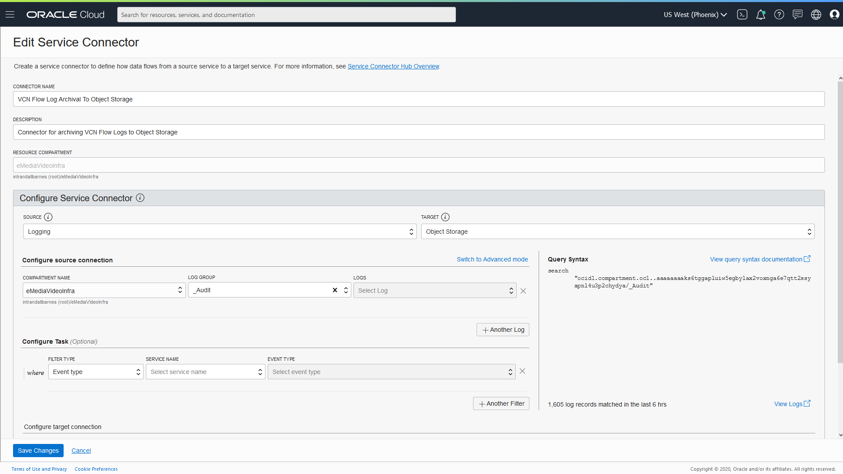
Figure 2: Service Connector Hub
Notifications
Oracle Cloud Infrastructure Notifications supports interoperability with several other third-party messaging platforms, including Slack, PagerDuty, and email. Customers can use Notifications with Service Connector Hub and Logging to facilitate remediation or near real-time alerting.
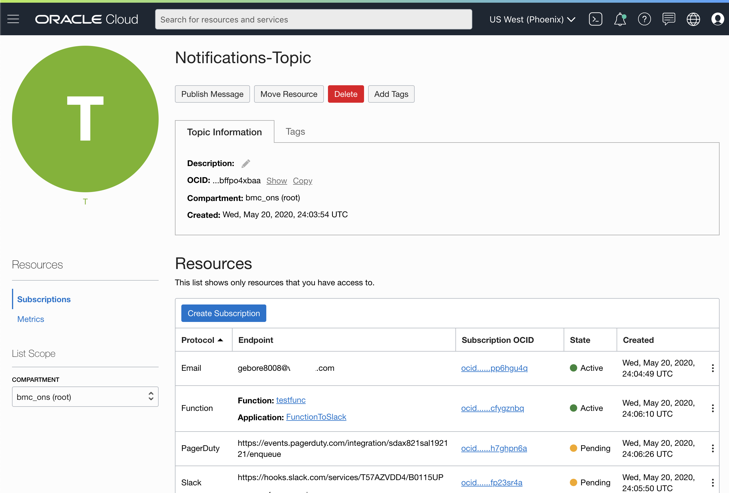
Figure 3: Notifications in OCI
Grafana plugin
Grafana has emerged as a popular, cloud native dashboarding technology for time-series data. Oracle has delivered a new Grafana plugin to make it easy for our customers to continue using Grafana for visualizing metrics and logs.
By using Oracle Cloud Infrastructure Monitoring as a metrics data source and Logging as a log source, cloud engineers can easily view metrics and logs for OCI on Grafana dashboards. By viewing metrics and logs side-by-side, engineers can rapidly resolve issues such as performance bottlenecks, service outages, and unusual network activity. The plugin also makes it possible to seamlessly view metrics from different providers, such as Amazon Web Services (AWS) and Oracle Cloud.

Figure 4: Grafana dashboards for OCI
Logging Analytics
Logging Analytics monitors, aggregates, indexes, and analyzes all log data from on-premises and multicloud environments and makes it easier for operators to find and resolve issues. With Logging Analytics, you can use the most advanced machine learning (ML), insightful visualizations, and smart analytics to deliver insights from massive data volumes—that is, “find the needle in a haystack.” For interoperability, the service provides more than 250 parsers across Oracle and third-party technologies, including Apache Cassandra, Apache Hadoop, Linux Syslog, and Oracle Cloud Infrastructure Audit.
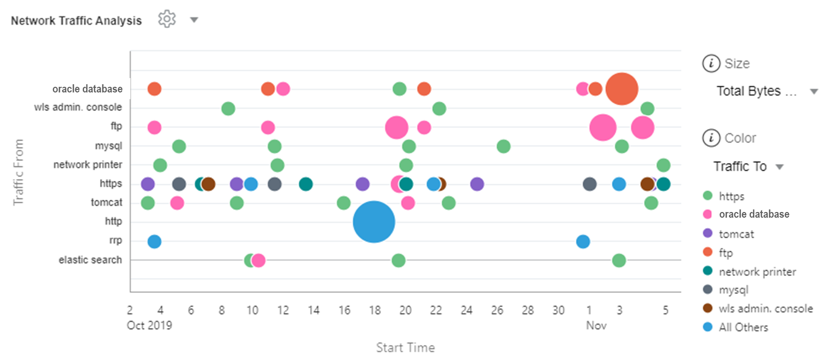
Figure 5: Logging Analytics
Application Performance Monitoring
Oracle Cloud Infrastructure Application Performance Monitoring (APM), in limited availability today, offers real and synthetic end-user monitoring, server monitoring, and distributed tracing. The service is compatible with open source, vendor-neutral projects called OpenTracing and OpenMetrics. Developers who have adopted these projects for profiling, monitoring, and analyzing their applications can easily use APM’s advanced capabilities for cloud native workloads.
Support for Cloud Native, in addition to traditional workloads
Oracle Cloud Infrastructure offers industry-leading price-performance and superior economics for workloads running on bare metal servers, virtual machines, GPU shapes, containers, or optimized database systems such as Exadata. OCI is the ideal cloud vendor for migrating traditional applications (E-Business Suite, PeopleSoft), middleware (Oracle WebLogic Server, open source Apache Tomcat), and databases (Oracle Database, MySQL), as well as custom applications written in any programming language.
Container Engine for Kubernetes
Oracle Container Engine for Kubernetes (sometimes referred to as OKE), the Oracle-managed and CNCF-certified Kubernetes offering, provides support today for flexible CPU shapes and upcoming support for flexible memory shapes. These shapes allow cloud operators and DevOps engineers to customize the CPU and memory resources of virtual machines (network bandwidth is scaled up or down automatically by Oracle).
Flexible shapes let you build compute instances that closely match your workloads, thereby increasing performance and reducing cost. Here are some other significant updates we have made to Container Engine for Kubernetes over the last year:
- Compliance certifications for SOC, ISO, C5, HIPAA, and other standards
- Kubernetes API server audit logging
- Kubernetes pod security policies
- Support for more admission controllers
- Support for the Container Storage Interface (CSI) volume plugin
- Custom boot volume size specification on worker nodes
- Improved node pool upgrades
- Private access to Oracle services with Service Gateway
- Full integration with Cloud Shell, a web-based Linux terminal within the OCI Console
As recently announced, Container Engine for Kubernetes is an option for Oracle WebLogic Server customers who use BYOL (bring your own license) and who are interested in a consumption-based model. WebLogic Server for Kubernetes is available in the Oracle Cloud Marketplace to enable you to rapidly build Java EE applications by using Oracle’s Universal Credit Model (UCM). For details, see the announcement for WebLogic Server consumption-based billing.

Figure 6: WebLogic Server in the Marketplace, and the architecture of WebLogic Server on Kubernetes
Based on the feedback from our customers, Container Engine for Kubernetes will soon offer the following new capabilities:
- Cluster node autoscaling, which will enable you to automatically scale the number of nodes in a Kubernetes cluster based on real-time demands of workloads
- Support for GPU shapes on worker nodes, which will let you accelerate your ML and data processing workloads
- Automatic cluster upgrades, which will simplify cluster management and reduce operational burden by automatically performing Kubernetes version upgrades based on your preferences
- Automatic repair of worker nodes, which will ensure that the worker nodes in a Kubernetes cluster are in a healthy state by performing periodic checks and initiating repair processes as needed
Also, Container Engine for Kubernetes will offer the following security-oriented features in 2021:
- Private clusters for Kubernetes: The cluster API server endpoint and worker nodes will have private IP addresses only, isolating them from the internet and restricting their access to Oracle internal network traffic only.
- Binary authorization support for Kubernetes: Only trusted and compliant container images will be deployed on Container Engine for Kubernetes using fine-grained policy driven controls.
- Customer-managed encryption keys for storage volumes: Boot and block volumes attached to worker nodes will be able to be encrypted by using the Oracle Cloud Infrastructure Vault service. The encryption keys can be generated either directly inside the service or imported from outside by using a “bring-your-own” model.
Oracle Functions
For Oracle Functions, our serverless offering based on the open source Fn Project, we recently announced some key enhancements to support more use cases:
- Support for functions running up to five minutes to let you run longer workloads
- Unified logging through integration with Logging
- Log-triggered functions with Service Connector Hub to help you analyze, enrich, and export log data to other systems
We also increased the number of functions that customers can run in their tenancies, from 20 functions to 500 functions for Universal Credit Model (UCM) customers and 50 functions for Pay-As-You-Go, Trial, and Promotional customers. Customers can submit a service limit increase request for larger needs.
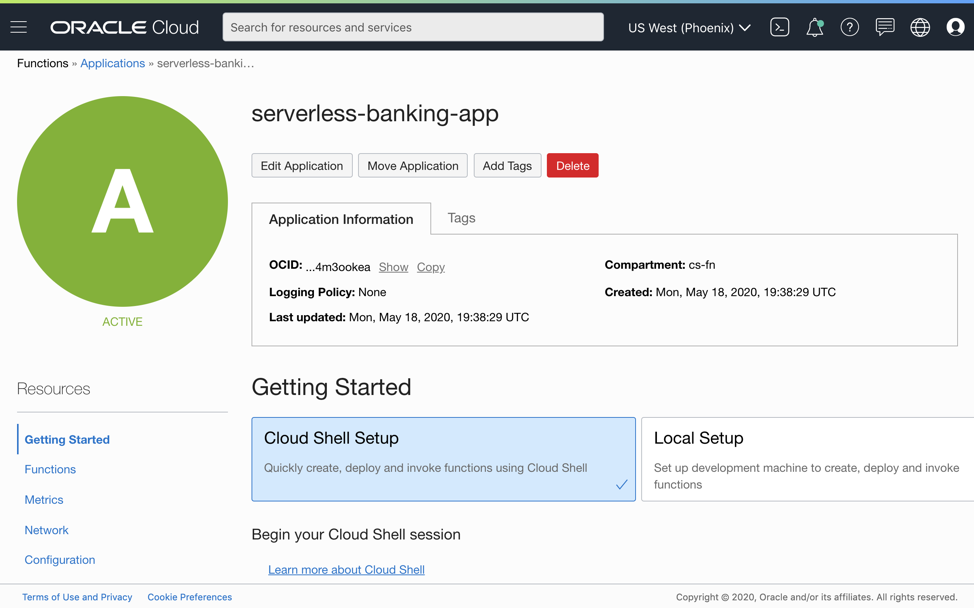
Figure 7: Oracle Functions
Distributed tracing capabilities in Application Performance Monitoring (APM) provide out-of-the-box instrumentation for microservices-based applications for a holistic view of application availability and performance. APM is in limited availability (LA) today, and you can submit a request for early access.
In addition, metrics and logs for Kubernetes worker nodes can be exposed via the Monitoring and Logging services. Metrics and logs for Kubernetes can also be exposed to Grafana by using the Grafana plugin.
Oracle Cloud Native services
Oracle Cloud Native services have also expanded the number of partners across security, federation, observability, and build automation to help customers continue to use their existing tools from the ecosystem as they use Kubernetes, Docker, and other cloud native technologies.
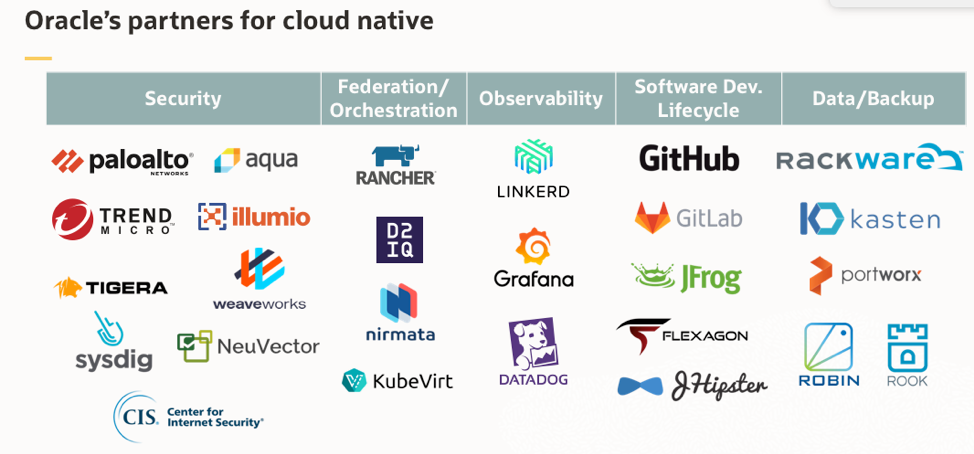
Figure 8: Partners for Oracle Cloud Native services
Summary
Oracle Cloud Infrastructure has adopted an open, standards-based approach that is vendor-agnostic and interoperable with the ecosystem. Oracle Cloud Infrastructure’s services are compatible with various open source standards and frameworks, such as Fluentd, CloudEvents, OpenTracing, OpenMetrics, CNCF-certified Kubernetes, Docker APIs, Terraform, and Apache Kafka. For more interoperability, Oracle has partnered with ecosystem vendors such as Grafana (for metrics and logs), PagerDuty and Slack (for alerting), Palo Alto Networks, Aqua Security, GitLab, Rancher, Linkerd, and RackWare.
I’m copresenting at KubeCon North America on the topics of machine learning, cloud native, Kubernetes, and serverless. I invite you to attend the session and talk with us at our virtual booth at KubeCon. To learn more, visit Oracle Observability and Management and Oracle Cloud Native.
You can also try Oracle Cloud for free and contact us for more information.
